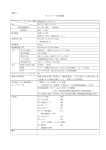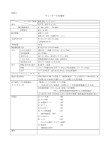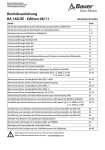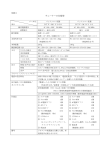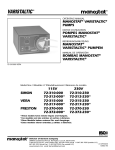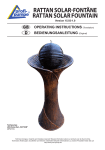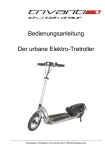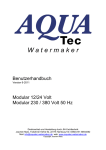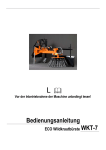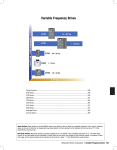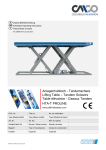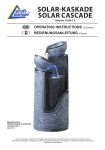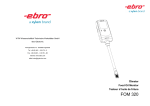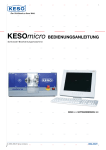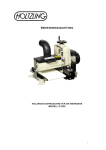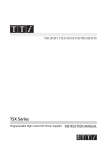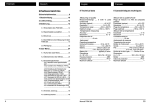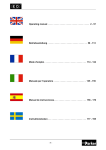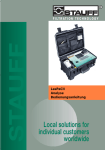Download Betriebs- und Wartungsanleitung für Hydraulikanlagen
Transcript
Betriebs- und Wartungsanleitung für Hydraulikanlagen Operating and maintenance instructions for hydraulic systems Mode d'emploi et d'entretien pour systèmes hydrauliques Sicherheitshinweise Security advices Indications de sécurité Vorsicht! Caution! Attention! Gefahrenhinweis. Diesem Hinweis ist zur Vermeidung von Verletzungen unbedingt Folge zu leisten! Information of danger. Observe this advice absolutely so as to avoid injuries! Indication de danger. Observez ce conseil absolument afin d'éviter des blessures! Wichtig! Important! Important! Sicherheitshinweis. Diesem Hinweis ist zur Vermeidung von Geräteschäden unbedingt Folge zu leisten! Security advice. Observe this advice absolutely so as to avoid damages at the equipment! Avis général de sécurité. Observez ce conseil absolument afin d'éviter des dommages à l'équipement! Einleitung Introduction Introduction Voraussetzung für den störungsfreien Betrieb der Hydraulikanlage, bzw. deren Komponenten ist die Befolgung der Betriebs- und Wartungsanleitung des Herstellers. Eine allgemeine Betriebs- und Wartungsanleitung für hydraulische Anlagen kann zwar wertvolle Hinweise für Inbetriebnahme und Instandhaltung geben, spezielle Anweisungen im Einzelfall jedoch nicht ersetzen. In order to ensure troublefree operation of hydraulic units and related parts, the manufacturer's operating and maintenance instructions have to be observed. General operating and maintenance instructions can provide useful tips for startup and installation, but cannot replace special instructions for specific cases. Pour un fonctionnement sans défaut du système hydraulique il est indispensable de suivre le mode d'emploi et d'entretien du fabricant. Un mode d'emploi et d'entretien général pour systèmes hydrauliques peut, certes, donner des indications précieuses au sujet de la mise en service et de l'entretien des systèmes hydrauliques, mais il ne remplacera pas les informations spécifiques aux cas particuliers. Aufgaben von Inbetriebnahme und Instandhaltung Responsibilities maintenance Responsabilités liées à la mise en service et la maintenance Inbetriebnahme Startup Mise en service Installation Installation Installation of Ölfüllung Oil filling Remplissage d'huile startup and Entlüftung Ventilation Purge Grundeinstellung Basic settings Réglage de base Einfahren Run-in procedure Mise en marche Instandhaltung Maintenance Maintenance Inspektion Inspection Contrôle Wartung Maintenance Entretien Instandsetzung Repair work Réparation Beobachtungen Observations Observations Messungen Measurements Mesures Probelauf Trial run Essai Reinigen und Austausch von Bauteilen - z.B. Ölwechsel, Filter, Dichtungen Cleaning and replacement of components - e.g. oil change, filter, seals Nettoyage et échange d' éléments - p. ex. remplacement d'huile, filtre, joints d'étanchéité Fehlersuche Trouble shooting Dépistage des défauts All rights, errors and changes reserved © Copyright HOERBIGER 2009 A7H006DEF07KAH30B Schadensanlayse Damage analysis Analyse de dommages 2 Schadensbehebung Remedy Remède Aus Sicherheitsgründen dürfen keine Leitungsverschraubungen, Anschlüsse und Geräte gelöst werden, solange die Anlage unter Druck steht. Zuvor sind Lasten abzusenken, Pumpen auszuschalten und Druckspeicher zu entlasten. Erhöhte Unfallgefahr beim Arbeiten mit öligen Händen. Achten Sie bei allen Arbeiten auf größte Sauberkeit, denn Schmutz ist der größte Feind jeder Hydraulik Alle Öffnungen sind mit Schutzkappen zu versehen, damit kein Schmutz ins System eindringen kann. Zum Reinigen von Ölbehältern, Rohrleitungen und Ventilen sind ausschließlich fusselfreie Materalien (keine Putzwolle etc.) zu verwenden. Befüllen der Anlage mit Öl nur über Filter (10 μm) Zum Lackieren sind alle elastischen Dichtungen sowie Lagerungen von beweglichen Teilen abzudecken bzw. abzukleben. Das Überlackieren von Schlauchleitungen ist zu vermeiden. For security reasons don't loosen any connections or devices while the system is pressurized. Before hand, the pressure has to be reduced,the pumps have to be switched off, and the accumulators have to be relieved. Increased danger of accident, when operating with oily hands. Make sure everything is absolutely clean before working, because dirt can cause major damage to hydraulic systems Equip all openings with protective caps so that dirt cannot penetrate into the system. For cleaning oil reservoirs, pipings and valves use fluff-free materials only (no finery wool etc..). Gerätemontage Befestigungsflächen müssen einwandfrei eben und sauber sein; Befestigungsschrauben sind mit dem vorgeschriebenen Anzugsdrehmoment anzuziehen Auf korrekte Einbaulage, Umgebungstemperatur, Betriebsspannung ist zu achten (Achtung: Manche Ventile sind mit einem Gleichrichterstecker ausgerüstet!) Ventile sind spannungsfrei zu montieren, um das Klemmen von Steuerkolben zu vermeiden Stufenbohrungen müssen einwandfrei fluchten, damit Gehäuseverspannungen vermieden werden. Unit assembly Mounting surfaces have to be perfectly even and clean; Mounting screws have to be tightened with the specified tightening moment. Pay attention to correct fitting position, ambient temperature and operating voltage (Attention: Some valves are provided with a rectifier socket!) must be assemled Valves free of stress in order to prevent the pilot pistons from jamming Step drills must be perfectly aligned, in order to avoid any distorsion of the housings. Assemblage Les embases doivent être parfaitement propres et planes, les vis de fixation doivent être serrées en respectant le couple de serrage indiqué. La position correcte de montage, la température ambiante et la tension de fonctionnement doivent être respectées (Attention: Certaine valves sont équipées de connecteur redresseur!) Les distributeurs doivent être montés sans alimentation électrique afin d'éviter le blocage de tiroir de pilotage. Les perçages étagés doivent être parfaitement alignés pour éviter toute contrainte sur le corps du des distributeurs. Leitungsinstallation Folgende Punkte sind bei der Leitungsinstallation zu beachten: nur nahtloses Präzisionsstahlrohr verwenden Leitungen vor dem Einbau von Zunder, Sand, Schmutz, Spänen usw. säubern Installation of tubes and pipes The following points have to be observed when installing the tubes and pipes: Only use seamless precision steel pipes Remove scale, sand, dirt and chips from pipes before assembly Installation de la tuyauterie Les points suivants sont à respecter lors de l'installation des tuyauteries : Utilisez uniquement des tubes d'acier de précision sans soudure. Avant le montage enlevez mâchefer, sable, poussière, ébarbures etc. des tuyaux. Only fill oil into the system via a filter (10 μm) When painting, cover all elastic seals and bearing arrangements of movable parts (if necessary with adhesive tape). Avoid to varnish flexible tubes. 3 Pour des raisons de sécurité il est interdit de dévisser les conduits, raccords,et composants lorsque le système est sous pression. Il faut auparavant diminuer les charges, éteindre les pompes et décharger les accumulateurs de pression. Il existe un risque d'accident élevé lors des travaux effectués avec des mains grasses. Respectez lors de tous travaux une propreté maximale. La saleté est l'ennemie numéro un de tout système hydraulique. Tous conduits et ouvertures doivent être protégées par des capuchons de protection pour qu'aucune saleté ne puisse entrer dans le système. Pour nettoyer les réservoirs à huile, les tuyauteries et distributeurs, l'utilisation de matériaux ne peluchant pas (pas de chiffon de laine etc.) est obligatoire. Le remplissage d'huile s 'effectue seulement par filtration (10 μm). Lors de travaux de peinture tous les joints ainsi que tous support de pièces mobiles doivent être protégés. Evitez de peindre les flexibles. All rights, errors and changes reserved © Copyright HOERBIGER 2009 A7H006DEF07KAH30B verschweißte Rohre sind zu beizen und zu spülen bei der Auswahl von Rohren, Schläuchen und Anbauteilen ist auf ausreichende Wandstärke sowie das richtige Material zu achten Rohre sind spannungsfrei zu verlegen, auch so, daß sie keine Vibrationen übertragen können Hydraulikschläuche müssen torsionsfrei, mit ausreichendem Biegeradius und immer mit Durchhang montiert werden. Welded pipes have to be steeped in corrosive fluid and flushed. When selecting pipes, tubes and connecting parts, make sure you have chosen the adequate wall thickness and the correct material. Pipes have to be placed free of stress and in installed way that they cannot transmit vibrations. Hydraulic hoses have to be mounted free of torsion, they have to mounted with a sufficient bending radius and always with sag. Les tuyaux soudés doivent être décapés et rincés. Lors du choix des tuyaux, flexibles et pièces de montage, faire attention aux épaisseurs de paroi suffisantes et aux matériaux adaptés. Les tuyaux doivent être placés sans contrainte de façon à ce qu'ils ne puissent transmettre aucune vibration. Des tuyaux hydrauliques doivent être montés exempt de la torsion, ils doivent monté avec un rayon de cintrage suffisant et toujours avec le fléchissement. Die Rohranschlüsse sowie die Gewindetiefen sind so ausgebildet, daß sowohl Verschraubungen mit Dichtkanten als auch Elastomer-Abdichtungen verwendet werden können. Zur Abdichtung dürfen auf keinen Fall Hanf und Kitt verwendet werden. Das Gewinde darf nicht am Bohrungsgrund aufsitzen. Überwurfmuttern müssen ausreichend fest angezogen werden. Dabei gilt: Nach einem merklichen Kraftanstieg The tube connections and the depths of thread have been made to suit screw connections with sealing edges and elastomer seals. Never use hemp and putty for sealing. The thread mustn't be touch the bottom of the bore. Swivel nuts have to be tightened sufficiently. Please note: Fix the swivel nut until an increase of the thightening force is achieved. Then tighten the nut for another 1/4 turn, when the fitting Les raccords de tuyaux de même que les profondeurs de filetage doivent être réalisés de façon à permettre l'utilisation de raccords avec arêtes d'étanchéité d'élastomère. Pour l'étanchéification il ne faut en aucun cas utiliser du chanvre ou du mastic. Le filetage ne doit pas toucher le fond du perçage. Les raccords doivent être suffisamment serrés. Mettez en Bild 2: Nomogramm zur Ermittlung des Rohr-Innendurchmessers 250 400 200 100 150 100 50 50 40 30 20 15 10 9 8 7 6 5 4 [mm] 40 30 20 15 10 9 8 7 6 5 4 3 2,5 Durchflußgeschwindigkeit / Rate of flow / Vitesse d'écoulement [m/s] 150 3 2 All rights, errors and changes reserved © Copyright HOERBIGER 2009 A7H006DEF07KAH30B Fig. 2: Abaque pour détermination du diamètre intérieur de tuyauterie Empfohlene Ölgeschwindigkeiten 200 300 Volumenstrom / Volume flow / Débit [l/min] Fig. 2: Nomogram for the determination of the internal tube diameter 4 0,3 0,4 0,5 0,6 0,7 0,8 0,9 1 1,5 2 Saugleitungen Rücklaufleitungen Druckleitungen bis 100 bar Druckleitungen bis 315 bar 0,5...0,8 2...4 2...4 3...12 m/s m/s m/s m/s 0,5...0,8 2...4 2...4 3...12 m/s m/s m/s m/s Recomended oil flow velocity Suction lines Return lines Pressure lines up to 100 bar Pressure lines up to 315 bar 3 4 5 6 7 8 9 10 Vitesses du fluide recommandées Tuyauteries d'aspiration Lignes de retour Lignes de pression jusqu'a 100 bar Lignes de pression jusqu'a 315 bar 0,5...0,8 m/s 2...4 m/s 2...4 m/s 3...12 m/s muß die Überwurfmutter noch eine 1/4Umdrehung (metallisch dichtend) bzw. 1/2-Umdrehung (elastomerdichtend) angezogen werden. Zylinder können in jeder beliebigen Einbaulage montiert werden, außer Hydraulikzylinder, deren Einbaulage auf Grund der Konstruktion auf eine bestimmte Lage fixiert ist. Kolbenstange und Zylinderrohr dürfen durch den Einbau nicht verspannt sein. Verrohrung durch Kurzschließen kräftig spülen. Leitungsdimensionierung Zur Bestimmung des Rohr-Innendurchmessers bei der Leitungsinstallation ist das Nomogramm (Bild 2) hilfreich. Inbetriebnahme Nach ordnungsgemäß ausgeführter Montage kann mit der Inbetriebnahme und Funktionsprüfung begonnen werden. Vorbereitungen Allgemeine Sichtprüfung auf Transportschäden und Verunreinigungen Ist der Tank gereinigt? Sind die Leitungen gereinigt und sauber montiert (Rohr- und Schlauchleitungen spülen)? Sind Verschraubungen und Flansche angezogen? Sind Leitungen, elektrische Verdrahtung bzw. Geräte gemäß Einbauzeichnung bzw. Schaltplan richtig angeschlossen? (Bei Magnetventilen und Zusatzgeräten wie Druckschalter und Thermostat auf richtige Spannung und richtigen Anschluß achten. Geräte sind für 100 % Einschaltdauer ausgelegt, Spannungsschwankungen von ± 5 % der Betriebsspannung sollten nicht überschritten werden) Sind die Dichtungen oder auch ein eventuell vorgesehener Innenanstrich gegen das verwendete Hydrauliköl beständig? Die Standarddichtungen sind gegen Mineralöl beständig; bei Verwendung von anderen Druckflüssigkeiten müssen eventuell Sonderdichtungen verwendet werden. Es ist darauf zu achten, daß das Betriebsmedium bereits bei der Bestellung der seal is metal, or for an 1/2 turn when the fitting seal is elastomer. Cylinders can be installed in any required position except for hydraulic cylinders which are limited to a special installation position due to their design. Don't distort the piston rod and the cylinder barrel when assembling. Thoroughly flush piping by shortcircuiting. Tube dimensioning The nomogram can be of some help when determining the internal diameter of a tube before installation (figure 2). Startup contact le raccord jusqu'au serrage, puis serrer d'un 1/4 de tour supplémentaire pour les joints métalliques et d'un 1/2 tour supplèmentaire pour les joints en élastomère. Les vérins peuvent être montés dans n'importe quelle position, à l'exception des vérins hydrauliques dont la position de montage est définie par la construction même. Le montage ne doit pas provoquer de contrainte entre la tige du piston et le corps du vérin. Bien rincer la tuyauterie par mise en court-circuit. Dimensionnement des conduits Pour définir le diamètre intérieur du tuyau lors de l'installation des lignes, veuillez consulter l'abaque (figure 2). Mise en service After having installed the system according to the instructions the performance tests can be started. Preparations General visual inspection for determining possible damage in transit contamination Has the tank been cleaned? Have the tubes been cleaned and properly installed (flush pipes and tube lines)? Have the screw connections and flanges been tightenend? Have the lines, the wiring, and other devices been correctly connected according to the mounting and circuit diagrams? (Pay special attention to correct voltage and correct connection with solenoid valves and auxiliary units such as pressure switches and thermostats. The units are designed for 100% operating time, fluctuations of the operating voltage shouldn't exceed ±5%) Are the seals or the possibly planned paint for interior painting resistant to hydraulic oil? HOERBIGER units produced in series are not provided with interior painting, unless especially requested by the customer. The seals normally used are resistant against mineral oil; when using other fluids, special seals possibly have to 5 Après un montage correct, vous pouvez passer à la mise en service et au contrôle fonctionnel. Préparations Contrôle visuel général concernant d'éventuels dommages de transport et polution. Le réservoir est-il nettoyé? Les conduites sont-elles nettoyées et proprement montées (rincer les lignes de tuyaux et flexibles)? Les raccords et flasques sont-ils bien serrés? Les conduites, câblages ou appareils électriques sont-ils installés correctement selon le plan de montage et le schéma de connexion? (Concernant les électrovannes et appareils supplémentaires, comme pressostats ou thermostats, vérifier les connexions et tensions. Les appareils sont conçus pour un taux de service de 100%, ne pas dépasser des fluctuations de tension de ±5 % de la tension de fonctionnement). Les joints ou des travaux de peintureintérieure envisagés sont-ils adaptés au fluide hydraulique utilisé? Les joints standardsrésistent aux huiles minérales; en cas d'utilisation d'autres fluides hydrauliques il peut être nécessaire d'utiliser des joints particuliers. Il est absolument impératif d'indiquer le fluide envisagé All rights, errors and changes reserved © Copyright HOERBIGER 2009 A7H006DEF07KAH30B Anlage angegeben wird; ein späterer Umbau auf Sonderdichtungen ist meist nur schwer und oft gar nicht möglich. Sind alle kraftübertragenden Teile ausgerichtet? Wird dies nicht beachtet, so ist z.B. bei Hydraulikzylindern ein frühzeitiger Verschleiß der Dichtungen und Führungen zu erwarten, beim Antriebsmotor eine Zerstörung der Pumpe möglich. Sind Filter mit vorgeschriebener Feinheit eingebaut? Sind Filter in Durchflußrichtung richtig montiert? Ist das vorgeschriebene Öl bis zur oberen Ölstandsmarke eingefüllt? (Siehe Hinweise "Druckflüssigkeiten"). Bei Speicherbetrieb sind die dafür vorgesehenen Blätter A7H005 und A7H007 zu beachten. be used. Please make sure the operating medium is stated when placing the order; later installation of special seals is difficult, sometimes even impossible. Have all the power transmitting parts been aligned? If alignment isn't performed, e.g. the seals and guides of hydraulic cylinders are more likely to wear out and the pump of the drive motor could be destroyed. Have filters with the correct mesh size been installed? Have the filters been installed in flow direction? Has the required oil been filled up to the upper oil level mark? (See notes on "Pressure fluids"). For accumulator operation see the respective data sheets A7H005 and A7H007. au moment de la commande; une modification ultérieure et un remplacement par des joints spécifiques est dans la plupart des cas très difficile à voire impossible à réaliser Toutes les pièces de transmission sontelles ajustées? En cas de non-respect de ce point, une usure prématurée des joints et des guidages de vérins, voire même la destruction de la pompe est possible. Les filtres montés sont-ils de la finesse prescrite? Sont-ils montés en tenant compte du sens d'écoulement du fluide? L'huile prescrite est-elle versée jusqu'à l'indicateur de maximum? (Voir les indications "Fluides sous pression"). En fonctionnement avec accumulateur les indications données dans les fiches techniques A7H005 et A7H007 sont à prendre en compte. Probelauf Nur das Personal des Maschinenherstellers, sowie evtl. Wartungsund Bedienunspersonal sollte anwesend sein. Druckbegrenzungsventil entlasten. Umlaufventil muß auf Umlaufstellung stehen (falls vorhanden) Stimmt Drehrichtung des Antriebsmotors mit vorgeschriebener Drehrichtung der Pumpe überein? Kurz einschalten und testen. Die Drehrichtung ist über einen Pfeil gekennzeichnet. Saugventile der Pumpe öffnen (falls vorhanden). Bei einigen Pumpentypen muß das Gehäuse mit Öl gefüllt werden. Pumpe starten und auf Geräusche achten Umlaufventil schalten (falls vorhanden) Anlage spülen, nach Möglichkeit durch Kurzschließen der Verbraucher. Solange spülen, bis die Filter sauberbleiben; Filterkontrolle! Entlüften der Anlage an den Verbraucherleitungen möglichst am höchsten Punkt. Richtungsventile betätigen und Zylinder mehrfach bis zum Anschlag aus- und einfahren. Belastung langsam steigern. Einstellwerte von Druckventilen bzw. Druckreglern Trial run Only the manufacturer's personnel and possibly maintenance and operating personnel should be present. Is the pressure relief valve completely open? Bring the bypass valve into open centre position, if available. Does the direction of rotation of the drive motor correspond to the given direction of rotation of the pump? Quickly switch on and check the direction of rotation is indicated by arrow. Open the suction valves of the pump, if available. If necessary, fill pump housing with oil. Start pump and pay attention to noises. Switch bypass valve if available Flush the system, if possible, by short-circuiting the consuming devices. Rinse, until the filters remain clean; Check filters! Exhausting of the system at the lines for consuming devices, if possible at the highest point. Actuate the directional valves and let the cylinder perform several forward and reverse strokes up to the stop. Slowly increase pressure. Increase set values of pressure relief valves or pressure regulators. Ventilation is guaranteed if there is no oil foam in the tank, if there are no jerky Essai Seul le personnel du fabriquant ainsi que le personnel d'entretien et les opérateurs devraient être présents. Décharger le limiteur de pression. Le distributeur bypass doit être en position ouverte (si existant). Le ssens de rotation du moteur est-il identique au sens de rotation de la pompe? Mettre brièvement en marche et tester. Le sens de rotation est indiqué par une flèche. Ouvrir la valve d'aspiration de la pompe (si existante). Pour certains types de pompes les cartère doit être rempli d'huile. Commuter la pompe et faire attention au bruit. Mettre en circuit le distributeur bypass (si existant). Rincer le système, si possible par mise en court-circuit des actionneurs. Rincer jusqu'à ce que les filtres restent propres ; contrôle des filtres ! Purger le système au niveau des branchements, au point le plus élevé possible. Actionner les distributeurs directionnels: sortir et entrer la tige des vérins jusqu'à butée. Augmenter doucement la charge. Augmenter les réglages des limiteurs de pression respectivement régulateurs de pression. La purge est garantie quand il n'y a pas d'écume d'huile dans le réservoir, pas de mouvement All rights, errors and changes reserved © Copyright HOERBIGER 2009 A7H006DEF07KAH30B 6 erhöhen. Entlüftung ist gewährleistet, wenn kein Ölschaum im Behälter, keine ruckartigen Bewegungen am Verbraucher und keine anormalen Geräusche auftreten. Funktion ohne Belastung der Anlage prüfen, wenn möglich von Hand fahren. Nach Erreichen der Betriebstemperatur Anlage unter Last überprüfen. Druck langsam erhöhen. Kontroll- und Meßgeräte überwachen Auf Geräusche achten Ölstand überwachen, ggf. nachfüllen Einstellung von Druckbegrenzungsventilen durch Belasten oder Abbremsen der Anlage überprüfen. Dichtheitskontrolle Antrieb abschalten Alle Verschraubungen, auch wenn diese dicht sind, nachziehen movements by the consuming devices and no unusual noises. Check the functions of the system without excercising pressure. Run the system manually if possible. After reaching the operating temperature check the system under pressure. Slowly increase pressure. Constantly watch the control and measuring equipment. Pay attention to unusual noises. Watch oil level, if necessary add more oil. Check setting of pressure relief valves by applying pressure or by slowing down the system. Leak test Switch off drive unit. Tighten all screw connections, even if they do not leak. saccadés des actionneurs et pas de bruits anormaux. Contrôler le fonctionnement du système hors charge, si possible actionner manuellement. Après avoir atteint la température de fonctionnement, contrôler le système sous charge. Augmenter doucement la pression. Surveiller les dispositifs de contrôle et de mesure. Faire attention aux bruits. Surveiller le niveau d'huile, en ajouter si nécessaire. Contrôler le réglage des limiteurs de pression en chargeant ou freinant le système. Contrôle d'étanchéité. Arrêter le moteur. Resserrer tous les raccords même s'ils sont étanches. ACHTUNG! Nachziehen nur bei druckloser Anlage ATTENTION! Only tighten if the system is not pressurized. ATTENTION ! Resserrer seulement lorsque le système est hors pression. Volle Funktionserprobung der Anlage. Meßwerte mit den zulässigen bzw. geforderten Daten vergleichen (Druck, Geschwindigkeit, Einstellen der weiteren Steuergeräte) Ruckartige Bewegungen weisen u. a. auf noch vorhandene Lufteinschlüsse hin. Die Anlage ist dann voll entlüftet, wenn alle Funktionen ruckfrei und mit gleichförmigem Lauf ausgeführt werden und die Oberfläche des Ölspiegels ohne Schaum ist. Schaumfreiheit sollte erfahrungsgemäß spätestens eine Stunde nach dem Start eintreten. Temperaturkontrolle Die vom Hersteller des Druckmediums empfohlenen Maximaltemperaturen sollten zur Schonung des Druckmediums möglichst nicht überschritten werden, unabhängig davon sollte eine Öltemeratur von 70°C nicht überschritten werden. Um ein gleichbleibendes Ansprechverhalten der Anlage zu gewährleisten empfiehlt es sich, die Öltemperatur konstant (± 5°C) zu halten. Die Isolierung der Standardmotoren entspricht der Isolierstoffklasse F nach der VDE Bestimmung 0530. Die zulässige Umgebungstemperatur beträgt 40°C. Complete performance test of the system. Compare the measured values with the permissible or required data (pressure, speed, adjustment of further control units) Jerky movements may indicate unnoticed inclusions of air. The system is completely exhausted, if all funtions are performed jerk-free, the systems runs smoothly, and the surface of the oil level is without foam. Experience has shown that the oil surface should be without foam at the latest one hour after starting the system. Check temperature For a better preservation of the pressure medium, the maximum temperatures recommended by the manufacturer should, if possible, not be exceeded; independent there of an oil temperature of 70°C should not be exceeded. In order to guarantee constant response characteristics of the system the oil temperature should be kept at a constant value (±5°C). The insulation of the standard motors corresponds to the insulation class F according to the VDE regulations 0530. The admissible ambient temperature is 40°C. Essai complet du système. Comparer les mesures obtenues avec les données limite ou de référence (pression, vitesse, réglage des appareils de commande supplémentaires). Des mouvements saccadés indiquent, entre autres, des bulles d'air restantes. Le système est purgé complètement à partir du moment où toutes les fonctions s'effectuent sans saccades, la surface du niveau d'huile est sans écume. Par expérience, la disparition de l'écume doit être réalisée au bout d'une heure de mise en service. Contrôle de température. Les températures conseillées par le fabricant du fluide hydraulique ne doivent pas être dépassées afin de préserver celui-ci. En outre la température d'huile ne devrait pas dépasser 70°C. Pour garantir un bon fonctionnement du système il est conseillé de maintenir la température d'huile constante (± 5°C). L'isolation des moteurs standards correspond à la classe d'isolation F selon le règlement VDE 0530. La température ambiante maximale est de 40°C. 7 All rights, errors and changes reserved © Copyright HOERBIGER 2009 A7H006DEF07KAH30B Antrieb abschalten Filtereinsätze ausbauen und auf Rückstände untersuchen und ggf. tauschen. Bei weiterem Schmutzanfall ist ein zusätzlicher Spüllauf erforderlich, um vorzeitigen Ausfällen der Anlagenkomponenten vorzubeugen. Alle vorgenommenen Einstellungen in einem Abnahmeprotokoll festhalten. Inspektion und Wartung Switch off drive unit Disassemble filter cartridges and check for residues and possibly change it. In case of further contamination, an additional flush will be necessary in order to prevent early defects of system components. Note all adjustments carried out in a test certificate. Inspection and maintenance Arrêter le moteur. Démonter les filtres et vérifier s'il y a des résidus et si nécessaire changer les filtres. En cas de saleté supplémentaire un cycle supplémentaire de rinçage est nécessaire afin d'éviter l'usure des composants du système. Noter tous les réglages effectués dans un rapport. Contrôle et entretien HOERBIGER Hydraulikkomponenten haben die konstruktiven Voraussetzungen für einen langen störungsfreien Betrieb. Eine Anlage arbeitet nur dann störungsfrei, wenn die Betriebs- und Wartungsanweisungen genau befolgt werden. Erfahrungsgemäß ist der größte Teil der auftretenden Störungen und Schäden auf schlechte Wartung, falsche Ölwahl und Schmutz zurückzuführen. HOERBIGER hydraulic components were designed for long and troublefree operation. A system can, however, only work without defects, if the operating and maintenance instructions are strictly observed. Experience has shown that most of the occuring trouble and damage are due to bad maintenance, the choice of wrong oil and contamination. Les composants HOERBIGERHydraulique sont conçus pour un usage prolongé sans défaillances. Un système peut travailler sans défaillance seulement à condition de respecter scrupuleusement le mode d'emploi et d'entretien. Par expérience la majorité des pannes constatées est due à un mauvais entretien, un mauvais choix de l'huile ou à la polution. Druckflüssigkeitsstand Ein Unterschreiten des erforderlichen Flüssigkeitsstandes (und damit des Flüssigkeitsvolumens) führt zum Anstieg der Betriebstemperatur, zur Luftansammlung, was zum Ausfall der Pumpe durch Kavitation führen kann. Der Druckflüssigkeitsstand ist täglich, bzw. an jedem Betriebstag der Anlage zu überprüfen. Pressure fluid level If the oil level drops below the required fluid level (and therefore drops below the fluid volume) the operating temperature rises, air collects, which can then lead to failure of the pump due to cavitation. Check the fluid level of the system daily respectively on every operating day of the system. Niveau du fluide Un niveau insuffisant de fluide (donc un volume insuffisant) provoque une augmentation de la température de fonctionnement ainsi qu'une importante quantité d'air qui risque de provoquer une panne de la pompe par cavitation. Le niveau du fluide sous pression doit être vérifié quotidiennement. Temperatur der Druckflüssigkeit Die vom Hersteller des Druckmediums empfohlenen Maximaltemperaturen sollten zur Schonung des Druckmediums möglichst nicht überschritten werden, unabhängig davon sollte eine Öltemeratur von 70°C nicht überschritten werden. Um ein gleichbleibendes Ansprechverhalten der Anlage zu gewährleisten, empfiehlt es sich die Öltemperatur konstant (± 5°C) zu halten. Bei plötzlich starken Temperaturerhöhungen ist die Anlage sofort abzuschalten und zu überprüfen. Temperature of pressure fluid The maximum temperatures for the pressure fluid recommended by the manufacturer should not be exceeded in order to better preserve the pressure fluid, independently there of an oil temperature of 70°C should not be exceeded. In order to guarantee constant response characteristics of the system, the oil temperature should be kept at a constant value (±5°C). If the temperature suddenly rises, the system has to be switched off and checked immediately Température du fluide Les températures conseillées par le fabricant du fluide ne doivent pas être dépassées afin de préserver celui-ci. En outre la température d'huile ne devrait pas dépasser 70°C. Pour garantir un bon fonctionnement du système il est conseillé de maintenir la température d'huile constante (± 5°C). Lors de fortes et soudaines augmentations de températures, le système doit être immédiatement arrêté et un contrôle effectué. Alterungsgrad der Druckflüssigkeit Tabelle 2 gibt Aufschluß über den Zustand der Druckflüssigkeit durch einfache Sichtbeurteilung. Genauere Aussagen können nur nach erfolgter Laboruntersuchung getroffen werden. Ageing of pressure fluid Table 2 shows how to judge the condition of the fluid by visual inspection. Exact statements can only be made after a detailed inspection in a laboratory. Degré de vieillissement du fluide Le tableau 2 informe sur l'état du fluide par simple jugement visuel. Des affirmations plus précises ne peuvent être faites qu'après une analyse en laboratoire. All rights, errors and changes reserved © Copyright HOERBIGER 2009 A7H006DEF07KAH30B 8 Tabelle 2: Druckflüssigkeitszustand durch optische Beurteilung Fig. 2: State of pressure fluid by visual judgement Fig. 2: État du fluide hydraulique par jugement optique Befund Result Résultat Verunreinigung Contamination Pollution mögliche Ursache possible cause cause possible Dunkelfärbung Dark colour Coloration foncée Oxidationsprodukte Oxidation products Produits d'oxydation Überhitzung, versäumter Ölwechsel (ggf. Fremdölzutritt) Overheating, oil change not carried out (possible penetration of oil from connected units) Surchauffe, vidange négligée (évtl. huile étrangère) milchige Trübung milky turbidity opacification lumineuse Wasser oder Schaum Water or foam Eau ou mousse Wassereinbruch, Lufteintritt Intrusion of water, air inlet Intrusion d'eau, entrée d'air Wasserabscheidung Water separation Séparation d'eau Wasser Water Eau Wassereinbruch, z.B. Kühlflüssigkeit Intrusion of water, e.g. cooling agent Intrusion d'eau, p.ex. liquide de refroidissement Luftbläschen Air bubbles Bulle d'air Luft Air Air Lufteintritt, z.B. infolge Ölmangel, undichte Saugleitung Air access, e.g. due to lack of oil, leaky suction line Entrée d'air, p. ex. suite au manque d'huile, conduite d'aspiration perméable schwebende oder abgesetzte Verunreinigungen Drifting or settled contamination pollutions en suspens ou en dépôt feste Fremdstoffe Abrieb, Schmutz, Alterungsprodukte solid impurities Wear, dirt, ageing products substances étrangères solides Abrasion, saleté, produits de vieillissement Geruch nach verbranntem Öl Smell of burnt oil Odeur d'huile brûlée Alterungsprodukte Ageing products Produits de vieillissement Überhitzung Overheating Surchauffe Wechsel der Druckflüssigkeit Der erste Ölwechsel hat unmittelbar nach Inbetriebnahme zu erfolgen. Weitere Ölwechsel werden alle 20003000 Betriebsstunden notwendig. Normale Betriebsbedingungen sowie regelmäßiger Filterwechsel sind hierfür Voraussetzung. Durch labormäßig überwachte Ölfüllungen und eine entsprechende Ölpflege lassen sich die Wechselintervalle unter Umständen erheblich verlängern. Changing of pressure fluid The first oil change has to be performed directly after the startup. Further oil changes are necessary every 2000-3000 operating hours. Preconditions are, however, normal operating conditions and regular filter changes. If the oil fillings are controlled by a laboratory and if the oil is adequately treated, the intervals between oil changes can be much longer. Vidange du fluide sous pression La première vidange doit être effectuée immédiatement après la mise en service. D'autres vidanges seront nécessaires toutes les 2000 à 3000 heures de fonctionnement. Des conditions de fonctionnement normales ainsi que l'échange régulier des filtres sont nécessaires au maintien de ce rythme. Grâce aux contrôles du remplissage d'huile en laboratoire ainsi qu'à une particulière attention au comportement de l'huile, les intervalles de vidange peuvent être considérablement prolongés. Filter (Kontrolle und Wechsel) Filter ohne Verschmutzungsanzeige sind erstmals nach der ersten Inbetriebnahme zu wechseln. Danach sind die Filter alle 250 Betriebsstunden zu überprüfen und ggf. auszuwechseln (Filtertöpfe mitreinigen). Achtung bei Filtertausch: neben Staub, Sand, Farbe etc, schadet auch Wasser dem Betriebsmedium. Filter mit Verschmutzungsanzeige sind täglich nach Erreichen der Betriebstemperatur zu kontrollieren. Filter (check and change) Filters without contamination indicators have to be changed for the first time after the first startup. Then the filters have to be checked every 250 operating hours and, if necessary, changed (also clean the filter casings). Be careful when changing the filter: besides dust, sand and paint, etc., also water hurts to the operating medium. Filters with contamination indicators have to be checked daily after the operating temperature is reached. Depending on the environmental conditions, the performance of Les filtres (contrôle et échange) Les filtres sans indicateur de pollution doivent être remplacés pour la première fois immédiatement après la mise en service. Ensuite ils doivent être vérifiés et le cas échéant remplacés toutes les 250 heures de fonctionnement (nettoyer également le tambours de filtre). Attention lors du changement de filtre : en plus de la poussière, du sable, de la peinture etc. l'eau endommage également la qualité du fluide hydraulique. Les filtres avec indicateur de pollution doivent être contrôlés quotidiennement dès qu'ils atteignent leur température de 9 All rights, errors and changes reserved © Copyright HOERBIGER 2009 A7H006DEF07KAH30B Belüftungsfilter sind je nach Umweltbelastung auf ihre Funktionsfähigkeit zu überprüfen und ggf. auszutauschen. ventilation filters has to be checked and, if necessary, the filters exchanged. fonctionnement. Les filtres d'aération doivent être vérifiés au niveau de leur fonctionnalité selon les différentes conditions dues à l'environnement et le cas échéant être remplacés. Schlauchleitungen Schlauchleitungen sind mindestens einmal jährlich auf ihren arbeitssicheren Zustand durch einen Sachkundigen zu prüfen. Die Verwendungsdauer der Schlauchleitungen sollte 6 Jahre nicht überschreiten. Auch bei sachgemäßer Lagerung und zulässiger Beanspruchung unterliegen Schläuche und Schlauchleitungen einer natürlichen Alterung. Daduch ist ihre Lagerzeit und Verwendungsdauer begrenzt. Schlauchleitungen müssen vor äußeren Einflüssen geschützt werden, wie z.B. starke UV-Strahlung, Lösungs- und Reinigungsmittel, Kraft- und Schmierstoffe oder hohe Ozonbelastung - wie sie z.B bei Elektroschweißarbeiten auftritt. Siehe DIN7716 bzw. DIN20066. Die Hydraulikschlauchleitungen müssen nach Ablauf der Verwendungsdauer von einem Sachkundigen gewechselt werden. Flexible tubes Flexible tubes are to be examined at least once annually for their work-safe condition by experts. The use duration of the flexible tubing should not exceed 6 years. Also with appropiate storage and permissible operating the flexible tubes have a natural ageing. Thus its storage time and use duration are limited. Flexible tubes have to be protected against environmental influences e.g. strong ultraviolett radiation, resolvents, detergents, fuels and lubricants,or a high ozone concentration e.g. appearing during electrical welding. See also at the standards DIN7716 and DIN20066. The flexible tube must be changed after expiration of the use duration from experts. Flexibles Une vérification annuelle doit être faite par une personne compétente. L'utilisation des mêmes flexibles ne doit pas dépasser 6 ans: ceci est aussi valable lors du stockage dans de bonnes conditions, puisqu'il y a un vieillissement naturel de la matière. C'est pourquoi le stockage et la durée d'utilisation est limitée. Les flexibles doivent être protégés contre les agressions extérieures, comme les radiations d'ultraviolets, les solvants, les détergents, les carburants, les lubrifiants ainsi qu' une forte concentration d'ozone émise par la soudure électrique. Voir aussi norme DIN7716 et DIN20066. Les flexibles doivent être remplacés par une personne compétente une fois leur durée de validité atteinte. Speicherbetrieb Außer den gesetzlich vorgeschriebenen Prüfungen ist der Gasvorspannungsdruck zu überwachen. In der Einlaufphase sind die Messungen häufiger durchzuführen. (Beachten Sie die Sonderblätter A7H005 und A7H007 für den Speicherbetrieb) Accumulator operation Besides the inspections required by law, the initial pressure of the gas has to be controlled. The measurements have to be performed several times during the run-in period. (Please see special data sheets A7H005 and A7H007 for accumulator operation). Fonctionnement avec accumulateur. En dehors des contrôles prévus par la loi il faut surveiller la tension du début de dégagement gazeux. Lors de la phase de mise en service cles contrôles doivent être effectués plus fréquemment. (Référez-vous aux fiches spécifiques A7H005 et A7H007 pour le fonctionnement avec accumulateur). Kühler Die Reinigungsintervalle hängen bei Öl-Luftkühlern vom Schmutzanfall aus der Umgebung, bei ÖlWasserkühler von Wassertemperatur, qualität und -durchsatz ab. Die Reinigung erfolgt mit Nylonbürsten oder chemisch. Cooler For oil-air coolers the cleaning intervals depend on the degree of environmental pollution, for oil-water coolers on the water temperature, quality, and flow rate. The cooler is either cleaned with nylon brushes or chemically. Radiateur Lesintervallesdenettoyagedépendent du taux de pollution dans l'environnement en ce qui concerne les radiateurs oléopneumatiques et de la température, de la qualité et de la teneur de l'eau en ce qui concerne les radiateurs hydrauliques. Le nettoyage se fait avec des brosses en Nylon ou de façon chimique. Einstellungen Die Einstellungen von Signalgliedern (z.B. Druckschaltern), von Druckventilen, Stromventilen sowie Pumpenreglern erfolgen bei der ersten Inbetriebnahme. Settings The setting of signal components (e.g. pressure switches), of pressure regulating valves, flow control valves, and pump regulators has to be performed after starting Réglages Le réglage des composants émettant des signeaux (p.ex. pressostats), des limiteurs de pression, des régulateurs de débit ainsi que ded régulateurs de pompe s'effectue lors de All rights, errors and changes reserved © Copyright HOERBIGER 2009 A7H006DEF07KAH30B 10 In der Anfangsphase sind diese Werte laufend, später in mittelfristigen Abständen zu kontrollieren. the system for the first time. In the beginning, these values have to be constantly controlled, later at medium-termd intervals. la première mise en service. Dans la phase de démarrage, ces valeurs doivent être contrôlées de façon continue, ensuite par intervalles réguliers plus espacés. Hydraulikzylinder Normalerweise sind die Hydraulikzylinder wartungsfrei. Bei Zylindern mit Gelenk- und Schwenklagern sind die normalen Schmierintervalle einzuhalten um die Lagerstellen vor übermäßiger Abnutzung zu schützen. Hydraulic cylinders Normally, the hydraulic cylinders are maintenance free. In cases of cylinders with pivoted bearings, one should perform lubrication at the usual intervals in order to protect the bearings from excessive wear. Vérins hydrauliques Normalement les vérins hydrauliques ne demandent aucun entretien. Pour des vérins à articulation mobile et à articulation pivotante, les intervalles de lubrification normaux doivent être respectés afin de protéger les pièces d'articulation d'une usure accélérée. Pumpen Die verwendeten Pumpen werden durch das Hydrauliköl selbst geschmiert und sind dadurch wartungsfrei. Die Wartung und Pflege beschränkt sich auf die peinliche Sauberhaltung des Hydrauliköls. Pumps The pumps used are automatically lubricated by the hydraulic oil and therefore need no maintenance. Maintenance is thus limited to painstakingly keeping the hydraulic oil clean. Les pompes Les pompes utilisées sont lubrifiées automatiquement par l'huile hydraulique et sont par conséquent sans entretien particulier. L'entretien et la maintenance se limitent à un respect absolu en ce qui concerne la propreté de l'huile hydraulique. Lagerung Zylinder sind bei Lagerung mit Öl zu füllen, da sonst die Gefahr der Rostbildung besteht (Kondenswasser). Mit Pumpen ist bei längerer Lagerung (mehr als 2 Jahre) ebenso zu verfahren. Ventile und Ventilsteuerungen sind bei längerer Lagerhaltung gegen Verharzung des Öls zu schützen. Storage When stored, the cylinders have to be filled with oil, otherwise they are likely to corrode (condensation water). The same applies to pumps if they are stored for more than 2 years. If valves and valve control units have to be stored for a longer period of time, one the oil must be prevented from gumming. Le stockage Lors d'un stockage prolongé (plus de 2 ans), les vérins doivent être remplis d'huile pour éviter qu'ils ne rouillent par condensation. En ce qui concerne les pompes il faut agir de la même façon. Les ditributeurs et commandes de distribution doivent être protégées contre la résinification de l'huile. Sonstiges Durch eine gewisse Aufmerksamkeit können beim Betrieb der Hydraulikanlage rechtzeitig Störungen erkannt werden. Frühzeitiges Erkennen von Störungen führt zu rechtzeitiger Schadensbehebung und somit zur Schadensminimierung. Achten Sie deswegen besonders auf: äußere Leckagen Geräusche Beschädigungen Verschmutzungen Funktionstüchtigkeit von Meßgeräten Other features With a certain degree of attention, defects during operation can become obvious at an early stage. If defects are recognized and eliminated early enough, greater damage to the system can be prevented. Therefore, pay special attention to: external leakage noise damage contamination functionability of measuring equipment Autres Grâce à une certaine vigilance des dysfonctionnements des systèmes hydrauliques peuvent être détectés rapidement. La détection des dysfonctionnements permet une réparation anticipée et minimise ainsi les dommages. Surveillez donc particulièrement : les fuites externes les bruits les endommagements la pollution l'état de fonctionnement des appareils de mesure Instandsetzung Eine erfolgreiche Schadensanalyse setzt genaue Kenntnisse über Aufbau und Wirkungsweise der einzelnen Komponenten und somit der gesamten Anlage voraus. Die Fähigkeit Schaltpläne und Funktionsdiagramme zu lesen, sowie Repair work Precondition for the successful analysis of damage is a detailed knowledge of the assembly and performance of the individual components and thus the whole system. The ability of reading circuit and performance diagrams and 11 Réparations Une bonne analyse des dommages demande une connaissance précise de la structure et du fonctionnement des différents composants et ainsi du système complet. La capacité de savoir lire les schémas de connexions et les All rights, errors and changes reserved © Copyright HOERBIGER 2009 A7H006DEF07KAH30B praktische Erfahrung erleichtern eine erfolgreiche Fehlersuche. Durch Meßgeräte und entsprechende Meßstellen können Fehler lokalisiert werden. Das Beheben lokalisierter Schäden kann durch Austausch defekter Komponenten vor Ort erfolgen. Reparaturen sollten durch den Hersteller, bzw. dessen Vertragswerkstätten vorgenommen werden. Grundsätzlich sollten auch die primären Ursachen für entstandene Schäden behoben werden. practical experience make troubleshooting a whole lot easier. With the help of measuring equipment and corresponding measuring points defects can be located. After having found the defective components, they can be exchanged in the field. Repair work should be carried out by the manufacturer or his contracting companies. Generally, also the primary causes for the resulting damage should be eliminated. diagrammes fonctionnels facilite considérablement une recherche de pannes. Les pannes peuvent être localisées à l'aide d'appareils de mesure et de points de contrôle. La réparation des dommages localisés peut être effectuée sur place en remplaçant les composants défectueux. Les réparations devraient être effectuées par le fabricant ou des réparateurs agrées. De manière générale les causes primaires des pannes rencontrées devraient également être éliminées. Störungen - Ursachen und Behebung Nachfolgende Aufstellung soll eine Hilfe zur Behebung von Störungen geben. Für weitere Fragen stehen wir Ihnen gerne zur Verfügung. Trouble, causes and trouble-shooting With the help of the following list, trouble-shooting can be performed. For further questions please do not hesitate to contact us. Dysfonctionnements - causes et solutions La liste suivante aide à résoudre des dysfonctionnements. Nous nous tenons à votre disposition pour des questions supplémentaires. 1. Undichtigkeiten Rohre, Schläuche und Verschraubungen im drucklosen System nachziehen (Anzugsmomente beachten) Hydraulikteile wie z.B. Ventile, Filter usw. mit neuen Dichtungen montieren Befestigungsschrauben der Ventile nachziehen (Anzugsmomente beachten) 1. Leaks Tighten pipes, tubes, and screw connections while the system is not pressurized (heed the tightening torque) Mount hydraulic parts such as directional valves, throttle valves, filters, etc. with new sealings Tighten valve mounting screws (heed the tightening torque) 1. Fuites d'huile Resserrer les tuyaux, flexibles et raccords du systèmehors pression (observez le couple de serrage) Monter les composants hydrauliques comme par ex. distributeurs, filtres etc. avec de nouveaux joints. Resserrer les vis de fixation des composants (observez le couple de serrage) 2. Druckabfall bzw. Betriebsdruck wird nicht erreicht Druckbegrenzungs- bzw. Druckreduzierventile auf Einstellung überprüfen ggf. austauschen Ölstand überprüfen Saug- und Druckleitung der Pumpe überprüfen Drehrichtung der Pumpe überprüfen Druck kann nur entstehen, wenn der austretenden Strömung ein Widerstand entgegengesetzt wird » Ventilstellungen prüfen « Prüfen, ob der Druck an der richtigen Stelle der Anlage abgelesen wird 2. Pressure drop or operating pressure is not reached Check setting of pressure regulating or pressure reducing valves. If necessary, replace them. Check oil level Check suction and pressure lines of pumps Check rotating direction of pump Pressure can only be built up if the resigning flow is opposed by some kind of resistor »check valve setting« Check if the pressure is read at the correct point of the system 2. Perte de pression ou pression de fonctionnement non atteinte Contrôler le réglage des limiteurs de pression resp. des réducteurs de pression et le cas échéant lesremplacer. Contrôler le niveau d'huile. Contrôler la conduite d'aspiration et de pression de la pompe. Contrôler le sens de rotation de la pompe. Il ne peut y avoir pression que s'il y a une résistance par rapport au courant »contrôler les positions des distributeurs« Surveiller si la pression est détectée au bon endroit du système. 3. Öl im Tank wird zu heiß Ölstand überprüfen Ggf. Kühler und Kühlleitungssystem überprüfen Bei Einsatz von Regelpumpen Nullhub-Förderstrom überprüfen Ggf. Thermostat für Heizung überprüfen 3. Oil in tank gets too hot Check oil level If necessary, check cooler and cooler tubing If variable capacity pumps are used, check the zero flow If necessary, check heater thermostat 3. L'huile dans le réservoir chauffe trop Vérifier le niveau d'huile. Si nécessaire réviser le système de refroidissement et de radiateur. En cas d'utilisation de pompe à débit variable, contrôler le débit du ventilateur. Si nécessaire contrôler le thermostat du chauffage. All rights, errors and changes reserved © Copyright HOERBIGER 2009 A7H006DEF07KAH30B 12 Falls der Öldruck zu hoch ist, Einstellungen aller Druckventile gemäß Schaltplan überprüfen If the oil pressure is too high, check all the pressure valves according to circuit diagram Si la pression d'huile est trop imporante, vérifier tous les réglages des distributeurs selon le schéma deconnexions. 4. Hubzeiten der Zylinder sind zu lang Drosselventile oder Stromregelventile nachjustieren Bei Druckabsicherung der Zylinder Einstelldruck überprüfen 4. Stroke time of the cylinders is too long Readjust throttle valves or flow control valves In case the cylinders are equipped with a relief valve, check the set pressure 4. Les cycles des vérins sont trop longs Réajuster les soupapes d'étranglement ou les régulateurs de débit. Lors de sécurisation de pression des vérins, vérifier le réglage du limiteur de pression. 5. Zylinder sinken zu schnell ab Brems- bzw. Gegenhalteventile überprüfen Zylinder überprüfen, ob Dichtungen in Ordnung sind ggf. Zylinderinnenwand auf Riefenbildung überprüfen Bei unregelmäßig arbeitenden Zylindern sind diese zu entlüften 5. Cylinders move out of locked position too quickly Check brake valve and retention valves Check if cylinder sealings are OK, if necessary check the internal wall of the cylinders for grooves If the cylinders do not run smoothly, they have to be exhausted 5. Les vérins descendent trop vite Vérifier le clapet de freinage ou la fonction de maintien. Contrôler les vérins, l'état des joints et le cas échéant l'intérieur des vérins. Si les vérins travaillent de façon irrégulière ils doivent être purgés. 6. Wegeventile arbeiten nicht Spannungen und Spannungsversorgung überprüfen Ventil über Notbetätigung überprüfen Ventil ggf. austauschen 6. Directional valves do not work Check voltage and voltage supply Check valve via emergency actuation If necessary, exchange valve 6. Les distributeurs directionnels ne fonctionnent pas Vérifier les tensions et l'alimentation en courant. Vérifier le distributeurà l'aide de la commande manuelle. Si nécessaire, changer le distributeur. 7. Pumpengeräusche sind zu groß Elektromotor überprüfen (z.B. Lüfter) Kupplung überprüfen Saug- und Druckleitung überprüfen Pumpe auf Verschleiß überprüfen ggf. Filter reinigen bzw.Patrone austauschen Flüssigkeitsspiegel im Behälter zu niedrig? Evtl. vorhandene Lufteinschlüsse entlüften 7. The pumps are too loud Check electric motors (e.g. ventilator) Check coupling Check suction and pressure lines Check pump for wear, if necessary clean filter or exchange cartridge Is the fluid level in the tank too low? If there are air inclusions, exhaust. 7. La pompe fait trop de bruit Vérifier le moteur électrique (par ex. le ventilateur). Vérifier le raccord. Vérifier la conduite d'aspiration et de pression. Contrôler l'usure de la pompe et éventuellement nettoyer le filtre ou changer la cartouche. Le niveau du fluide dans le réservoir est trop bas ? Purger les poches d'air éventuelles. 8. Verschmutzungsanzeige am Filter zeigt an Filter reinigen bzw. Filterpatrone austauschen 8. Contamination indicator for filter is activated Clean filter and/or replace filter cartridge 8. L'indicateur de pollution du filtre s'allume Nettoyer le filtre ou changer la cartouche. 13 All rights, errors and changes reserved © Copyright HOERBIGER 2009 A7H006DEF07KAH30B Druckmedien Pressure media Fluide hydraulique Die reibungslose Funktion, Lebensdauer, Betriebssicherheit und Wirtschaftlichkeit einer Hydraulikanlage hängt wesentlich von der Auswahl des verwendeten Druckmediums ab. Wir bevorzugen im allgemeinen die Verwendung von Hydraulikölen auf Mineralölbasis mit der Kennzeichnung HLP, da andere Druckmedien u.U. die Einsatzbedingungen der Geräte einschränken, bzw. nicht dafür geeignet sind. The reliable performance, a long service life, operating reliability and economic running of a hydraulic system largely depend on the choice of the adequate pressure medium.We exclusively favour the use of hydraulic oil on mineral oil basis with the characteristic of HLP. Other pressure media could limit the operating conditions of the units or are not suited for them. Le bon fonctionnement, la durée de vie, la sécurité de fonctionnement et la rentabilité d'un système hydraulique dépendent essentiellement du choix du fluide hydraulique. Nous conseillons généralement l'utilisation d'huiles hydrauliques minérales avec le label HLP, car d'autres huiles pourraient limiter le fonctionnement des systèmes respectivement n'être pas adaptées. Biologisch abbaubare Hydrauliköle Biologisch abbaubare Hydrauliköle sind Flüssigkeiten die von in Boden und Wasser befindlichen Mikroorganismen schnell abgebaut werden. Gesetzliche Bestimmungen, politische und morali- Biodegradable hydraulic oils Biodegradable hydraulic oils are fluids that can easily be decomposed by micro-organisms in the earth and water. Legal regulations, a political and moral responsibility for the environment and Les huiles hydrauliques biodégradables Les huiles hydrauliques biodégradables sont des fluides qui peuvent être décomposés rapidement par des microorganismes qui existent dans la terre et dans l'eau. Des exigences législatives, Bild 3: Viskositätsklassen nach ISOVG Fig. 3: Viscosity classes according to ISO-VG Fig. 3: Degré de viscosité suivant ISO-VG VG VG VG 15 10 0 10 VG 8 O 6 IS VG 6 O 4 IS VG O 32 IS VG 2 2 O IS O IS O O IS IS 1 000 max. 600 [mm2/s] 100 empfohlener Bereich für Dauerbetrieb recommended range for continuous operation plage recommandé pour fonctionnement continu 20 12 min. 10 9 8 7 6 5 -40 -30 -20 -10 0 10 20 Bezugstemperatur für ISO-Viskostätsklassen Reference temperature for ISO viscosity classes Température de référence pour classes de viscosité ISO All rights, errors and changes reserved © Copyright HOERBIGER 2009 A7H006DEF07KAH30B 30 40 50 60 Öltemperatur [°C] Oil temperature Température d'huile 14 70 80 90 100 sche Umweltverpflichtungen und auch der unternehmerische Leistungsdruck verlangen nach Einsatz solcher Öle. Sollten Sie sich für den Einsatz biologisch abbaubaren Öles entscheiden, empfehlen wir Ihnen PANOLIN HLP SYNTH (synthetischer Ester). the competition between companies necessitate the appplication of such oils. Should you decide to use biodegradable oil, we recommend PANOLIN HLP SYNTH (synthetic ester). des engagements politiques et moraux sur l'environnement mais aussi la concurrence industrielle réclament l'utilisation de ces huiles. Si vous décidez d'utiliser des huiles biodégradables, nous vous conseillons l'utilisation de PANOLIN HLP SYNTH (ester synthétique). Viskosität Die Viskosität eines Druckmittels gemessen in der SI-Einheit mm2/s, ändert sich mit der Temperatur. Viscosity The viscosity of a pressure medium measured in the SI-unit mm2/s changes in accordance with the temperature. Viscosité La viscosité d'un fluide de pression mesurée en mm2/s, unité du SI , se modifie en fonction de la température. Niedrige Viskosität (dünnflüssig) bedeutet: geringe Strömungsverluste, gute Pumpfähigkeit, gute Ansprechempfindlichkeit der Anlage, Low viscosity (thin-bodied oil) means: minor loss of flow rate, good pumpability, good response sensitivity of the system, Une viscosité basse (très liquide) signifie : des pertes de courant minimes, une bonne pompabilité, un bon seuil de fonctionnement de tout le système. Kennzeichen nach / Certification according to / Certification suivant / HLP 32 HLP 46 HLP 68 DIN51502 Panolin HLP Synth 32 Agip OSO-32, ARNICA-32, PRECIS-32 OSO-46, ARNICA-46, PRECIS-46 OSO-68, ARNICA-68, PRECIS-68 ARAL ARAL Vitam GF 32 ARAL Vitam GF 46 ARAL Vitam GF 68 BP BP Energol HLP-HM 32 BP Energol HLP-D 32, BP Bartran HV 32 BP Energol HLP-HM 46 BP Energol HLP-D 46, BP Bartran HV 46 BP Energol HLP-HM 68 BP Energol HLP-D 68, BP Bartron HV 68 ESSO NUTO H 32, HLPD-OEL 32 NUTO H 46 HLPD-OEL 46 NUTO H 68 HLPD-OEL 68 FINA FINA HYDRAN 32, FINA HYDRAN HLP-D 32 FINA HYDRAN 46, FINA HYDRAN HLP-D 46 FINA HYDRAN 68, FINA HYDRAN HLP-D 68 FUCHS-DEA RENOLIN MR10 VG 32, RENOLIN B 10 VG 32 RENOLIN MR15 VG 46, RENOLIN B 15 VG 46 RENOLIN MR 20 VG 68, RENOLIN B 20 VG 68 Mobil Mobil DTE 24 Mobil DTE 13 Mobil DTE 25, Mobil Hydraulik Oil Medium Mobil DTE 26, Mobil Hydraulik Oil Heavy Medium SHELL Shell Tellus Öl 32 Shell Tellus Öl 46 Shell Tellus Öl 68 TEXACO Rando HD-32 Rando HD-46 Rando HD-68 VALVOLINE Ultramax HLP-32 Ultramax HLP-46 Ultramax HLP-68 HLP Synth 46 HLP Synth 68 biologisch abbaubar / biodegradable / biodégradable 15 All rights, errors and changes reserved © Copyright HOERBIGER 2009 A7H006DEF07KAH30B aber: hohe Leck- und Schlupfverluste, abnehmende Schmierfähigkeit, Erwärmung und dadurch weiteres Absinken der Viskosität but: high degree of leakage and slip loss, reduced lubricity, increased temperature and thus a further drop of the viscosity. mais : de grosses pertes par fuite ou glissement, une diminution du pouvoir lubrifiant, un échauffement entraînant par conséquent une nouvelle diminution de la viscosité. Hohe Viskosität (dickflüssig) bedeutet: Strömungsverluste (Druckabfall) in Ventilen, Rohren und Schläuchen. Anlagenträgheit, abnehmende Pumpfähigkeit, führt zu Kavitationsproblemen, High viscosity (viscous oil) means: reduction of flow rate (pressure drop) in valves, pipes, tubes. Inertia of system, reduced pumpability result in problems with cavitation, Une viscosité élevée (consistant) signifie : Des pertes de courant (chute de pression) dans les distributeurs, tuyaux et flexibles. L'inertie et la perte de pompabilité provoquent des problèmes de cavitation, aber: gute Schmierfähigkeit, geringe Leckund Schlupfverluste, Alterungsbeständigkeit. Im Diagramm mit doppelt logarithmischem Maßstab für die Viskositätsachse (Bild 3) ergeben sich gerade Kennlinien für verschiedene Druckmittelsorten. Eine Einteilung in Viskositätsklassen nach ISO-VG geht von einer Bezugstemperatur von 40°C aus. Die Viskositätsklasse wird der Typenbezeichnung hinzugefügt z.B. HLP 46. Das Diagramm ermöglicht die Auswahl geeigneter Ölsorten für bestimmte Betriebstemperaturen. but: good lubricity, little leakage and lubricity loss, resistance to ageing. A diagram with double logarithmic dimensions for the viscosity axis (fig.3) results in straight characterisitic lines for different kinds of pressure media. The different viscosity classes according to ISO-VG are based on a reference temperature of 40°C. The viscosity class is completed by the type designation e.g. HLP 46. The diagram facilitates the choice of suitable oil types for different operating temperatures. mais : Une bonne capacité lubrifiante, des pertes par fuites et glissement minimes et une bonne résistance au vieillissement. Le diagramme à échelle logarithmique double pour l'axe des viscosités (fig.3) donne des lignes droites, caractéristiques de reconnaissance pour différentes sortes de fluides hydrauliques. Une classification en classe de viscosité selon ISO-VG est basée sur une température de référence de 40°C. La classe de viscosité est ajoutée au code de désignation, par ex. HLP 46. Ce diagramme permet le choix de l'huiles en fonction des températures de fonctionnement particulières. Ölempfehlung Einwandfreie Funktion, Betriebssicherheit und Lebensdauer hydraulischer Anlagen hängen wesentlich von der sorgfältigen Auswahl der Hydrauliköle ab. Wir empfehlen bei normalen Betriebsbedingungen HLP-Hydrauliköl nach DIN51524. Die auf Seite 15 aufgeführten Hydrauliköle entsprechen diesen Vorschriften. Die Reihenfolge der aufgeführten Hersteller bedeutet keine Qualitätseinstufung ihrer Sorten. Wechsel der Druckflüssigkeit - siehe Seite 8. Die Bedienungsanleitung der Hydraulikanlage hat für die Auswahl der Hydraulikflüssigkeiten Vorrang. Zur eingehenden Beratung unserer Kunden steht der Technische Dienst der Ölgesellschaften zur Verfügung. Falls andere Druckflüssigkeiten in Hydraulikanlagen eingesetzt werden sollen, bitten wir Sie, uns anzusprechen. Recommendations on hydraulic oil Faultless performance, operational reliability, and working life of hydraulic plants depend essentially on the correct choice of hydraulic oils. For normal operating conditions we recommend HLP hydraulic oil according to DIN51524. The hydraulic oils listed at page 15 all corresspond to these regulations. The order of the companies in the list is no indication for the quality of the different sorts of oil. Changing the pressure fluid - see page 8. The operating instruction for hydraulic systems has priority when choosing the correct hydraulic fluid. The technical service departments of the oil manufacturing companies can provide our customers with detailed advice. If inflammable fluids have to be used in hydraulic systems, please contact us. Choix de l'huile Un parfait fonctionnement, la sécurité de fonctionnement et la durée de vie des systèmes hydrauliques dépendent en grande partie du choix de l'huile hydraulique. Nous conseillons, dans des conditions de fonctionnement normales, de l'huile HLP selon DIN51524. Les huiles hydrauliques citées à page 15 correspondent à ces normes. L'ordre des fabricants cités ne correspond pas à un classement qualitatif. Vidange du fluide sous pression - voir page 8. Le mode d'emploi du système hydraulique est prépondérant dans le choix du fluide hydraulique. Pour une information complète, veuillez consulter les services techniques des sociétés pétrolières . Si d'autres fluides de pression devaient être utilisés, nous vous demanderions de prendre contact avec nous. All rights, errors and changes reserved © Copyright HOERBIGER 2009 A7H006DEF07KAH30B 16 Filtration Filtration Filtration Ein Großteil der Ausfälle von Hydraulikanlagen ist auf eine zu hohe Feststoffverschmutzung in der Hydraulikflüssigkeit zurückzuführen. Diese hohe Feststoffverschmutzung ist auf eine mangelnde Wartung der Anlage zurückzuführen. Eine wirksame Filtration in Hydrosystemen verhindert Störungen und erhöht gleichzeitig die Lebensdauer von wichtigen und teuren Komponenten. Sie ist kein notwendiges Übel, sondern eine zwingende Notwendigkeit.Die Begrenzung der Kosten für Reparaturen der Komponenten ist nur mit einer vorbeugenden Wartung der Hydraulikaggregate möglich. Durch ständige Ölkontrollen wird der momentane Zustand der Aggregate erfaßt. Bei Verschlechterung der Ölwerte können die notwendigen Gegenmaßnahmen eingeleitet werden. Damit wird der zu erwartende Schaden minimiert. Filterkontrolle und Wechsel - siehe Seite 9. Lots of trouble that occurs in hydraulic systems is caused by a considerable contamination of the hydraulic fluid with solid particles. This high solid contamination is reduced to an insufficient maintenance of the system. Only by means of preventive maintenance of the hydraulic power units the costs for repair work can be reduced. It is therefore not just a necessary evil, but an absolute necessity.Efficient filtration in hydraulic systems helps to avoid disturbances, at the same time it prolongs the service life of important and expensive equipment. The present condition of the power units can be determined by constantly checking the oil. If the oil values start to deteriorate, the necessary measures have to be taken. Possible damage can then be kept to a minimum. Filter check and change - see page 9. Une grande partie des pannes des systèmes hydrauliques est due à une présence trop importante de matières solides dans le fluide hydraulique. Cette pollution importante est due à un entretien insuffisant du système. Une filtration efficace des systèmes hydrauliques évite les pannes et augmente en même temps la durée de vie de composants essentiels et honéreux. Elle n'est pas un luxe mais une stricte nécessité. La limitation des coûts pour les réparations des composants n'est possible que par un entretien préventif des groupes hydrauliques. L'état momentané des groupes est contrôlé par la vérification constante de l'huile. Dès constattation d'une détérioration des caractéristiques de l'huile, il est possible de prendre des mesures pour y remédier. Ainsi le dommage éventuel est minimisé. Pour le contrôle et échange les filtres - voir page 9. Der x - Wert Da kaum ein Filtermaterial eine absolut 100 %ige Rückhalterate gewährleisten kann (bezogen auf die Partikelgröße), entstand der x - Wert, der diese Tatsache berücksichtigt. The x-value Since hardly any filter material can guarantee a retaining capacity of 100% (referring to the size of the particles), the x-value was set up taking this fact into condsideration. La caractéristique x Puisque pratiquement aucun matériau de filtrage ne peut garantir une filtration à 100% (en regard de la taille des particules) on a créé la valeur x qui prend en compte cette réalité. Grundlagen: Multi-Pass Test, ISO 4572 (hier wird die Rückhalterate eines Filters bestimmt, der mit definiert verschmutztem Öl durchströmt wird) Basic factors: Multi-Pass test; ISO 4572 (with this test the retaining capacity of a filter is determined, which is passedby a fluid with a clearly definded degree of contamination) Bases : Multi-Pass test, ISO 4572 (la capacité de rétention d'un filtre, rempli d'une huile polluée selon un calcul précis, est ici décrite.) Beispiel 10 = 75 Example 10 = 75 Exemple 10 = 75 Rückhalterate 75 : 1 Retaining rate 75 : 1 Capacité de rétention 75 : 1 Größe der Schmutz partikel in μm Size of dirt particles (μm) Taille des particules polluantes en μm prozentuale Rückhalterate [%] = 100 - 100/x retaining rate in percent [%] = 100 - 100/x Taux de rétention en pourcentage [%] = 100 - 100/x daraus folgt für x = 75 for x as follows = 75 ce qui a pour conséquence x = 75 prozentuale Rückhalterate [%] = 100 - 100/75 = 98,66 % retaining rate in percent [%] = 100 - 100/75 = 98.66 % Taux de rétention en pourcentage [%] = 100 - 100/75 = 98,66 % 17 All rights, errors and changes reserved © Copyright HOERBIGER 2009 A7H006DEF07KAH30B Bild 5: Verschmutzungsklassen nach NAS1638 Fig. 5: Contamination classes according to NAS1638 Fig. 5: Classes de colmatage suivant NAS1638 1 000 000 Zahl der Teilchen pro 100 cm³ Number of particles per 100 cm³ Nombre des particules par 100 cm³ 100 000 10 000 1 000 12 11 10 9 8 7 6 100 10 5 10 15 25 50 Teilchengröße / Size of particles / Dimension de particules NAS - Verschmutzungsklasse Der Grad der Verschmutzung eines Druckmittels läßt sich durch Teilchengröße und Konzentration definieren. Zur Einteilung in die richtige Verschmutzungsklasse dient Bild 5. In der amerikanischen Norm NAS 1638 werden Teilchen mit einer Größe von 5 μm bis 100 μm berücksichtigt. 1) NAS = National American Standard 2) SAE = Society of Automotive Engineers 3) ISO 100 [μm] NAS - Contamination class The degree of contamination of a pressure fluid can be defined by the size of the particles and their concentration. For the correct assignment of the contamination class see Fig. 5. The American standard NAS 1638 includes particles with a size ranging from 5 μm to 100 μm. Classe de pollution NAS Le degré de pollution d'un média de pression se définit par la taille et la concentration des particules. Pour la classification dans la classe de pollution correspondante voir figure 5. La norme américaine NAS 1638, prend en compte les particules d'une taille de 5μm à 100μm. Further recommendations and instructions for installation, startup, maintenance, and operation of hydraulic systems and components according to CETOP and/or ISO and DIN standard have to be observed. En outre, les conseils et modes d'emploi concernant le montage, la mise en service et la manipulation de systèmes hydrauliques selon CETOP ou ISO et DIN sont à respecter. = International Standard Organisation Des weiteren sind Empfehlungen und Anleitungen für Einbau, Inbetriebnahme, Wartung und Bedienung hydraulischer Anlagen und Komponenten laut CETOP bzw. ISO- und DIN-Norm zu beachten. All rights, errors and changes reserved © Copyright HOERBIGER 2009 A7H006DEF07KAH30B 18 Bild 6: Überblick über Verschmutzungsklasse, Filterfeinheit und Hydrauliksystem im Vergleich der verschiedenen Normen Verschmutzungsklasse Contamination class Classe de colmatage NAS16381) ISO44062) 6 184)/15/12 7 194)/16/13 Fig. 6: Overview of contamination class, grade of filtration and hydraulic system in comparison of the different standards zu erreichen mit Filter can be reached with filter atteinte avec le filtre SAE3) 3 4 bx = 75 Fig. 6: Aperçu des classes de pollution, d'unité de filtration et de système hydrauliques au regard des différentes normes Hydrauliksystem Hydraulic system Système hydraulique Material Material Materiel Anordnung Arrangement classement Servoventile Servo valves servodistributeurs 3 Druckfilter Pressure filter filtre de anorganisch z.B. Glasfaser pression 5 Regelventile Control valves distributeurs de régulation inorganic e.g. glassfibre 8 9 4) 20 /17/14 214)/18/15 5 6 inorganique par ex. fibre de verre 10 Proportionalventile Proportional valves Distributeur proportionnel Rücklaufoder Druckfilter 20 Return or pressure filter 10 224)/19/16 - Pumpen und Ventile allgem. Pumps and Valves in general Filtre de retour ou de pression 25 Pompes et distributeurs classiques organisch z.B. Papier 11 234)/20/17 244)/21/18 - Rücklauf-, Saug- oder Teilstromfilterung organique p.ex. papier Niederdrucksysteme in Mobilhydraulik und Schwerindustrie Low pressure systems in mobile hydraulics and heavy industry Système à basse pression pour applications mobiles et industrie lourde Return-, suction- or partial flow filter - Filtration partielle, de retour ou d'aspiration 4) p<160bar organic e.g. paper 25 ... 40 12 p>160bar 3-stelliger Code nur bei Einsatz eines Automatischen Partikelzählers (APC) 4) 3-digit code only by the use of an automatic particle counter (APC) 19 4) Code avec 3 chiffres seulement par l'utilisation d'un compteur automatique de particules (APC) All rights, errors and changes reserved © Copyright HOERBIGER 2009 A7H006DEF07KAH30B A A B C CDN CH CZ DK E F HU I IND J L MY NL P ROC SGP Sl SK THA TR USA USA ZA HOERBIGER VENTILWERKE GmbH • Braunhubergasse 23 • 1110 Wien • Tel.01-74-004-0•Fax.01-74-34-222-222•Mail:[email protected] RIMSER HYDRAULIK SERVICE GmbH • Fabrikgasse 15 • 2603 Felixdorf • Tel. 02628-61707 • Fax. 02628-61707-18 • Mail: [email protected] GANDAFLUID NV • Scheldestraat 15 • 9820 Merelbeke • Tel. 09210-0570 • Fax. 09231-0624 • Mail: [email protected] HOERBIGER (WUXI) Automation Technology Co., Ltd. • Science & Technology Business Incubator Anzhen Xidong Park, Xishan EDZ, 214105 Wuxi • Tel.0510-85203468 • Fax.0510-85203498 HANSEN Technical Service INC. • 5327 Windermere Drive • L7L 3M2 Burlington, Ontario • Tel. 0905 681-3973 • Fax. 0905 681-0321 • Mail: [email protected] VEKTOR AG • Chriesbaumstrasse 4 • 8606 Volketswil • Tel. 044-9082222 • Fax. 044-9082233 • Mail: [email protected] RYBA FRANTISEK HYDRAULIKA BRNO • Svazna 1/1 • 63400 Brno • Tel. 0547223096 • Fax. 0547223096 • Mail: [email protected] HVL Harald v. Lassen A/S • Hvedemarken 16 • 3520 Farum • Tel. 044 340-110 • Fax. 044 340-115 • Mail: [email protected] AUTOMATIC SYSTEM PARTNER • Poligono Industrial el C/ Nogal No. 8 • 28110 Algete (Madrid) • Tel. 091 629 09 00 • Fax. 091 628 25 54 • Mail: [email protected] HOERBIGER TECHNIQUES D'AUTOMATISATION • 17, rue du Rothbach • 67500 Marienthal • Tel. 03 388936174 • Fax. 03 388073586 • Mail: [email protected] HOMAS Kft • Zrinyi utca 109 • 1196 Budapest • Tel. 01 3581274 • Fax. 01 2803830 • Mail: [email protected] MUSE S.R.L. • Via Vittorio Veneto 9/E • 20091 Bresso (Milano) • Tel. 002 66501064 • Fax. 002 6140400 • Mail: [email protected] KIP INDUSTRIAL HYDRAULICS Pvt.Ltd. • 116, Dayal Nagar • 144002 Jalandhar • Tel. 0181-251264 • Fax. 0181-250347 • Mail: [email protected] SOLAS Corporation Co., Ltd. HOERBIGER Office • #5012-17-11 Shinyokohama, Kohoku-ku • 222-0033 Yokohama • Tel. 045476-0636 • Fax. 045476-0637 • Mail: [email protected] GANDAFLUID NV • Scheldestraat 15 • 9820 Merelbeke • Tel. 09210-0570 • Fax. 09231-0624 • Mail: [email protected] KIP INDUSTRIAL HYDRAULICS • 400 Orchard Road, Orchard Tower #15-06 • 238875 Singapore • Tel. 06835-7545 • Fax. 06738-3797 • Mail: [email protected] INRADA ING. BUR. DE RAAY EN DATEMA BV. • 's-Gravelandseweg 375 • 3125 BJ Schiedam • Tel. 010 2080700 • Fax. 010 2080799 • Mail: [email protected] HOERBIGER - ORIGA S.A. • Rua das Dozes Casas 235 • 4000 Porto • Tel. 0122 5507179 • Fax. 0122 5092251 • Mail: [email protected] HOERBIGER TAIWAN LTD. • 1 Floor, No. 12, Alley 31, Lane 190 Dershing East Road, Shilin • Taipei • Tel. 833 5337 • Fax. 836 2901 • Mail: [email protected] KIP INDUSTRIAL HYDRAULICS • 400 Orchard Road, Orchard Tower #15-06 • 238875 Singapore • Tel. 06835-7545 • Fax. 06738-3797 • Mail: [email protected] INOTEH D.O.O. • Ruska cesta 34 • 2345 Bistica ob Dravi • Tel. 62 66 51131 • Fax. 62 66 52081 • Mail: [email protected] FLUIDTECHNIK spol. s.r.o. • Mareka Culena c.11 • 97411 Banska Bystrica • Tel. 048 4148636 • Fax. 048 4144522 • Mail: [email protected] KIP INDUSTRIAL HYDRAULICS • 400 Orchard Road, Orchard Tower #15-06 • 238875 Singapore • Tel. 06835-7545 • Fax. 06738-3797 • Mail: [email protected] BCB OTOMASYON ÜRÜNLERI San.Ve.Tic Ltd.Sti Y. Dudullu • Serif Ali Cad.Kuru Sok. No. 12 • 81260 Istanbul • Tel. 0216 3650005 • Fax. 0216 3147482 • [email protected] H&B eurotech INC. • 8651 Buffalo Avenue, unit # 5 • 14304 Niagara Falls, New York • Tel. 905 681-3973 • Fax. 905 681-0321 • Mail: [email protected] HOERBIGER • 2313 University Court • IL 60565 Naperville, Illinois • Tel. 630 778-3995 • Fax. 630 778-3995 • Mail: [email protected] EURO AUTOMATION TECHNOLOGY (PTY) Ltd. • 9, Fuchs Street, Alrode • P.O. Box 17846 • 1457 Randhart • Tel. 011 908-1310 • Fax. 011 908-1312 • Mail: [email protected] HOERBIGER AUTOMATISIERUNGSTECHNIK GmbH Südliche Römerstraße 15 86972 Altenstadt, Deutschland Tel. Fax. +49 (0)8861 221-0 +49 (0)8861 221-13 05 E-Mail: [email protected] www.hoerbiger.com




















